The Fabric of Discovery
Katelyn King
Senior, College of Engineering

Medium
Quilt
Abstract
This quilt integrates thirty panels that imitate rows of a bookshelf with science equipment nestled among the volumes. Beginning from the top left, the panels depict one of Darwin’s finches, a human brain, a framed diagram of a DNA helix, Thomson’s cathode ray tube, Newton’s prism, Katherine Johnson’s electronic computing machine, Rutherford’s gold foil experiment, a microscope, a centrifuge, Mendel’s pea plants, a human heart, a test tube, Rosalind Franklin’s Photo 51, a micropipette, a Faraday coil and magnet, a petri dish, the Miller-Urey experiment, a Cavendish balance, one of Marie Curie’s radioactive notebooks, a syringe, and a mouse.
I constructed this piece via paper-piecing – a quilting technique that involves sewing fabric to a temporary paper foundation to stabilize complex designs. The design consists of thirty detailed panels that imitate rows of a bookshelf with various pieces of science equipment nestled among the volumes. I designed every pattern myself in Google Drawings, sketching lines and shapes over stock images of the design I sought to replicate. With the exception of a few yards of cotton fabric, I made every block with only recycled clothing, making extensive use of cotton t-shirts to vary my color palette. To create the shelves, I recycled old curtains which resembled dark wood in texture and hue. I joined these fabrics with a Singer sewing machine and reinforced the back of the quilt with blanket material.
On the top shelf, I’ve depicted one of Darwin’s finches, a human brain in a jar, and a framed diagram of the helical structure of DNA with multicolored bases. The second shelf contains the cathode ray tube with which J.J. Thomson demonstrated the existence of electrons, the prism that Isaac Newton used to refract light, and the electronic computing machine used by Katherine Johnson to calculate spaceflight trajectories for NASA. The third shelf displays the gold foil experiment by which Ernest Rutherford explained the structure of atoms, a microscope, a centrifuge with a pair of test tubes, and Gregor Mendel’s purple and white pea plants which demonstrated genetic inheritance. The fourth shelf contains a human heart in a jar, a test tube, a framed photo of Rosalind Franklin’s Photo 51 which revealed the helical structure of DNA, and a micropipette. The fifth shelf exhibits Michael Faraday’s demonstration of electromagnetic induction, a petri dish, and the Miller-Urey experiment which demonstrated abiogenesis. The final shelf displays a Cavendish balance which allows for calculation of the universal gravitational constant, one of Marie Curie’s radioactive notebooks, a syringe, and a mouse.
